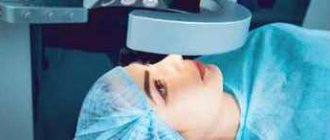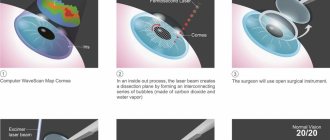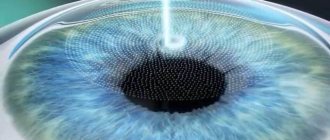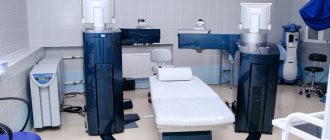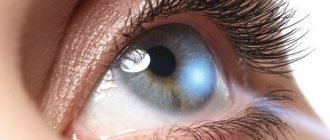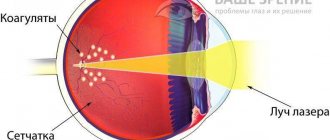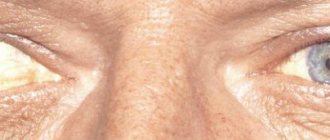ReLEx SMILE laser vision correction technology
Today it is the most progressive and most delicate procedure.
We talk about the advantages and disadvantages of this technique, as well as other, no less popular laser correction technologies, with Arseny Kozhukhov, Doctor of Medical Sciences, Professor, ophthalmic surgeon of the highest category at the Moscow ophthalmological clinic "SPECTR"
.
Arseniy Aleksandrovich, everyone talks so much about Smile, but it’s still not clear – is this a new type of laser or a new technique?
ReLEx SMILE is an ultra-precise laser vision correction technology. It uses the world's only femtosecond laser, VisuMax, manufactured by Carl Zeiss. Many believe that the name “Smile” comes from the shape of the incision on the cornea in the shape of a smile. This is partly true, but in fact, this is the name of the technology - Small Incision Lenticule Extraction
, which can be translated into Russian as “Extraction of a refractive lens (lenticule) through a small incision.”
The same laser (femtosecond) can be used for other operations. For example, for laser vision correction using the FemtoLASIK
.
How long have you been using Smile in your clinic?
The VisuMax femtosecond laser was installed in our clinic in October 2020. Today, this is the latest version of the laser available in Moscow clinics. This is a laser with an eye tracking system (eye movement tracking system). It kind of steers up if the patient moves his eye even minimally during the operation. But this does not mean that we have just started working with him. I have been using the ReLEx SMILE technology for more than four years and have performed about a thousand operations using this technology. In general, the technology has already existed in the world for more than 13 years.
Naturally, both equipment and algorithms have improved over the years. At Carl Zeiss, this technology has been thoroughly developed. But it must be said that competitors are appearing in the world who will enter the market in 2-3 years. They will have a similar technique, but a different name for the technology, since the name “Smile” has already been patented.
Sometimes you can find advertisements for clinics offering laser vision correction at very low prices, about 20,000 rubles...
Most likely it will be conventional LASIK using a microkeratome, i.e. a mechanical knife that makes a cut on the cornea and using a rather old excimer laser. When using this technique, there is a greater risk of complications than when using femtolaser technologies, the result is less stable and this is a technology that is becoming a thing of the past.
>> You can read about the evolution of laser vision correction methods HERE.
How can you comment on the opinions of some doctors who do not recommend using ReLEx SMILE, arguing that the technology is new and not yet proven?
The ReLEx SMILE technique is no longer so new - it is more than 13 years old
. The first such operation in Russia was carried out in 2011, and in Europe in 2007. So the technology has already been around for over 13 years. Almost 3 million operations have already been performed worldwide. Imagine what clinical experience has been accumulated!
Of course, there are no operations with zero risk. But with the equipment we have and our experience, we get the best possible result with a 99.9% probability, which we discuss with the patient.
Negative things about Smile are usually said by clinics that do not have such equipment. Therefore, if you need an objective assessment, ask at clinics where all technologies are presented. I have a wide circle of professional acquaintances, and I have not yet seen a single surgeon who, having learned the Smile technique, would subsequently refuse to perform these operations.
Indications for surgery
The procedure is recommended for patients suffering from the following diseases:
- myopia – decreased visual acuity, when the patient sees poorly in the distance, but well near;
- hypermetropia - decreased visual acuity, when the patient sees well in the distance, but poorly near;
- Astigmatism is a violation of the shape of the eyeball, as a result of which not only visual acuity is reduced, but a person cannot normally perceive the shapes and figures of surrounding objects.
Using the technique, vision is restored instantly. The patient sees well on the day of the operation or a day later.
If we compare technologies, how do they differ for the patient?
- Trauma, sensations after surgery: - With FemtoLASIK, the incision is about 20 mm.
— With Smile – 2 mm. Therefore, with FemtoLASIK, epithelization takes 5-6 hours. During this period, there may be lacrimation and photophobia. With Smile, this effect goes away within an hour or two.
- If we talk about the long-term consequences, the result after Smile is more stable, due to the fact that there is no flap on the cornea.
- How is the ReLEx SMILE operation performed?
The most common question from patients is: “Will it hurt?”
No, this procedure is absolutely painless
.
Only drops are used for the operation, thanks to them the eye becomes insensitive. It takes 7-10 minutes for each eye. Usually both eyes are done on the same day. This is logical, since living with different eyes is not comfortable. But those who do not want to do both eyes at once do it one by one, for example, with a break of a week or a month. For the most fearful and emotional people with a mobile psyche, we have the opportunity to perform these operations under anesthesia
. It turns out that the patient fell asleep and woke up with excellent vision.
Contraindications
The technique is not performed in the following cases:
- acute viral and infectious diseases (ARVI, sore throat);
- exacerbation of a chronic disease (hepatitis, glomerulonephritis, tonsillitis);
- diseases that suppress the immune system (rheumatism, rheumatoid arthritis, congenital and acquired immunodeficiencies);
- progressive decrease in visual acuity;
- excessive thinning of the cornea, for example, with keratoconus, when the risk of rupture of this area due to the use of a laser increases;
- period of pregnancy and breastfeeding;
- age up to 25 years, since before this time a person’s eyes grow and change, so after the operation, vision may decrease again, which makes the method irrational;
- inflammatory process in the eyeballs;
- diabetes;
- diseases that can result in the formation of scars and adhesions on the surface structures of the eyes;
- serious ophthalmological diseases in the decompensation stage (glaucoma, cataracts, retinal detachment, optic nerve or retinal dystrophy).
If diseases or conditions are temporary, vision restoration is possible after complete recovery. But there are absolute contraindications when the technique is not feasible at any period of life. These conditions include diabetes mellitus, keratoconus, and serious abnormalities in the structure of the eyes.
RELEx SMILE
The most advanced technique. It is an improved version of FLEx technology. It involves removing a layer of the cornea through a small incision in it. Thus, the trauma and invasiveness of the operation are minimized.
Advantages of the method
- Complete absence of flap. Due to this, the likelihood of complications is reduced.
- Minimum corneal incision size (80% smaller than other methods).
- During the operation, only a femtosecond laser is used.
- Possibility of correction for patients with thin corneas and dry eye syndrome.
- Protection of the cornea and no risk of its displacement. When using the SMILE method, most of the upper layers of the cornea remain unaffected.
- Low risk of developing dry eye syndrome.
Indications and contraindications
Indications for surgery using SMILE technology:
- Myopia from −0.5 to −10 diopters.
- Astigmatism from −0.5 to −5 diopters.
- Myopia and myopic astigmatism from −0.5 to −12.5 diopters.
Contraindications:
- Progressive myopia.
- Infectious eye diseases.
- Taking corticosteroids.
- Autoimmune diseases and immunodeficiency conditions.
- Surgical interventions on the eyeball or cornea.
- Irregular astigmatism.
- Suspicion of glaucoma.
- Pregnancy.
- Age under 18 years.
Preparing for surgery
When preparing for surgery, you should adhere to the classic scheme:
- Visit to an ophthalmologist for examination and consultation.
- Complete eye diagnostics.
- Taking tests (blood, urine, HIV, Hepatitis, Syphilis).
Implementation of preoperative recommendations:
- Stop wearing contacts a couple of weeks before surgery.
- Do not drink alcohol or wear makeup the day before the procedure.
Advantages of Smile technology
The technique has advantages due to which doctors recommend it to patients:
- the smallest corneal incision, which heals quickly after completion of the procedure;
- minimal risk of complications;
- rehabilitation period no more than 2 weeks;
- no restrictions in the process of life after the operation, with the exception of visiting a bathhouse, sauna, sunbathing.
You can learn about all the positive aspects of the procedure from your attending physician.
Can older people have laser correction?
It is possible, but it is usually recommended to do it before the age of 45.
This is due to the fact that after 45 years, age-related changes in the lens
: it becomes denser, problems with near vision arise.
There is one of the many popular misconceptions that “with age, a minus changes to a plus.”
In fact, this is not at all the case; myopia remains as it was. It’s just that with glasses in which a person has always seen very well in the distance, he will no longer be able to see up close; he will need second glasses of a different optical power. Technically, it is possible to perform laser correction on such a patient. But the result will be one-sided. That is, he will get good distance vision, but he will have to read with glasses.
Laser technologies to eliminate age-related farsightedness
There are also some, but for the most part they are still in development. Now the Carl Zeiss company has developed a new PresBayond technology for the correction of presbyopia - age-related farsightedness. PresBayond allows you to form a multifocal lens from your own cornea without changing the lens.
Preparing for surgery
Before the procedure, the patient must do the following:
- stop wearing contact lenses 2 weeks before surgery;
- You should not take new medications 2 weeks before surgery that the doctor has not been warned about;
- you should not drink alcohol 2-3 days before the procedure;
- pass laboratory tests, conduct instrumental examination methods (general blood and urine tests, blood biochemistry, infection testing, ECG, fluorography, examination by an otolaryngologist, neurologist, dentist);
- wash your face and hair thoroughly on the day of surgery;
- come to the clinic on the day and time prescribed by the doctor.
A person must have with him medicinal drops and other medications prescribed by an ophthalmologist. In some clinics, protective glasses and a change of clothing are provided by medical staff. If such actions are not carried out, the clinic must warn about the need to purchase these items.
Sign up for a consultation and get a discount:
Can I
go to the pool or sauna after Smile?
We recommend that you avoid swimming in open water for two weeks after any refractive surgery. There are also similar restrictions for warming up procedures: after Smile we recommend refraining from visiting baths and saunas for two weeks, after Femto-LASIK - up to two months.
Surely, at the initial appointment, patients sometimes express concerns about the prognosis: “What if the result doesn’t work out?” What guarantees do you give?
I always say that there are no operations with zero risk. We cannot give a 100% guarantee - this is medical ethics. We can guarantee that the operation will be carried out as accurately as possible using technology.
We always discuss the prognosis with the patient in advance - what the vision will be like. Success depends not only on the available equipment, but also on the doctor, since no equipment can replace human work, on the sterile conditions in the clinic, and consumables. The doctors at our clinic have more than 30 years of experience in ophthalmic surgery. In Smile technology - more than 4 years.
What about the progression of the disease? For example, a person had great myopia, you corrected it. But then vision may continue to deteriorate?
Let's look at what myopia is. The eye is an optical system.
Myopia appears because at a certain age the eye begins to grow and lengthen. The optical system is adjusted to a specific focal length. The muscular apparatus of the eye can slightly change this distance. If the eye lengthens, the image on the retina is no longer focused into a point, but becomes a blurred circle. The eye is most elastic in childhood and adolescence. Therefore, myopia usually progresses until the age of 18, less often until 25.
There are rare cases when suddenly myopia begins to progress in adulthood. Most often, this is not true myopia, that is, not due to elongation of the eye, but due to other factors. The first option is initial cataract. The lens begins to thicken and “false” myopia appears. Therefore, if myopia suddenly begins to progress in an adult or even an elderly person, most likely it is a cataract. The second option is a disease called keratoconus, when the cornea gradually thins and stretches.
It turns out that laser vision correction can only be done after 18-25 years of age?
Yes.
But there are some cases when we do laser correction for children. For example, when a child has a huge difference in optical power between the eyes, large astigmatism, farsightedness, especially in combination with purely accommodative strabismus. You can “kill two birds with one stone” with one operation: correct your vision and eliminate strabismus.
Can older people have laser correction?
It is possible, but it is usually recommended to do it before the age of 45. This is due to the fact that after 45 years, age-related changes in the lens begin: it becomes denser, and problems with near vision arise. There is one of the many popular misconceptions that “with age, a minus changes to a plus.” In fact, this is not at all the case; myopia remains as it was. It’s just that with glasses in which a person has always seen very well in the distance, he will no longer be able to see up close; he will need second glasses of a different optical power.
Technically, it is possible to perform laser correction on such a patient. But the result will be one-sided. That is, he will get good distance vision, but he will have to read with glasses. Laser technologies for eliminating age-related farsightedness are also available, but for the most part are still in development.
What technology are we talking about?
Now Carl Zeiss has developed a new technology called PresBayond.
for the correction of presbyopia - age-related farsightedness. PresBayond allows you to form a multifocal lens from your own cornea without changing the lens.
And as for the negative consequences of severe myopia - possible retinal dystrophy, does laser correction not solve this problem?
Doesn't solve it. All our patients undergo a retinal examination. Sometimes, if we find dystrophic foci or tears, we can perform laser coagulation of the retina to prevent retinal detachment from occurring in the future.
By the way, if correction is carried out using the conventional LASIK method, the vacuum ring that is installed on the eye puts more pressure on the eye and the vacuum is stronger than with FemtoLASIK or SMILE, so the risk of retinal detachment with conventional LASIK is much higher. With FemtoLASIK and SMILE, which is performed using the VisuMax laser, the laser interface is suctioned to the limbal zone of the cornea, and not in the ciliary body zone (as with conventional LASIK). Therefore, there is no pressure on the area where the retina attaches to the ciliary body.
As a result, when performing laser correction we do not affect the retina. However, if there were problems with it, you need to be monitored regularly: undergo an examination once a year.
How to prepare for laser vision correction surgery?
At least the night before the examination, remove your contact lenses and do not put them on in the morning; come to the examination without lenses, or you can wear glasses. Before laser correction, you need to refrain from wearing contact lenses for one week to allow the cornea to recover. During this period it is better to wear glasses.
What about makeup?
The night before, remove all makeup and wash thoroughly. Come to surgery in the morning without makeup. After ReLEx Smile you can use makeup again the next day. After FemtoLASIK - after 5-6 days. This carries the risk of accidentally hitting the eye and dislodging the flap.
Thank you, Arseny Alexandrovich, for such a detailed analysis of the procedure! For those who do not understand the nuances of technology and because of this are afraid to undergo laser vision correction, such materials will be very useful!
Rehabilitation and postoperative period
Immediately after completion of the operation, the person feels severe discomfort, itching, burning, and pain in the eyes. By the end of the day, these symptoms go away. During the rehabilitation period, the patient must follow the following rules to eliminate the risk of complications:
- complete absence of visits to the bathhouse, sauna, swimming pool, absence of tanning in the open sun for two months after the operation;
- complete exclusion of physical activity for 1 week after surgery, then you can play sports little by little, bringing it to your usual regimen;
- use moisturizing drops as needed;
- use of anti-inflammatory drops in the dosage prescribed by the doctor;
- wearing sunglasses outdoors for 2 weeks after surgery;
- a repeat appointment with an ophthalmologist for an eye examination and medication adjustment.
The rehabilitation period ends with the doctor's permission. After this, the person can carry out his usual actions.
What is technology
ReLEx SMILE stands for Refractive Lenticule Extraction SMall Incision Lenticula Extraction - refractive removal of the lenticule through an ultra-small incision. This is the third, newer generation of laser technologies, which was preceded by PRK and LASIK (including femtosecond-assisted - Femto-LASIK). New technology has made it possible to correct visual impairment without creating a flap, which occurs with LASIK. The formed flap (“flap”) weakens the biomechanical properties of the cornea and creates the risk of its displacement in the future.
SMILE, unlike PRK, is painless, the main restrictions after the operation are removed the next day. Recovery of visual acuity after PRK takes several months.
How does the patient feel?
In the operating room, the patient is placed on the operating table, given instructions, and anesthetic drops are instilled for local anesthesia.
After this, a special spring (eyelid expander) is inserted, which will not allow you to blink during the procedure. All manipulations are painless. The patient is then moved directly under the laser. All that is required of you is to look at the green light and not move your eye.
The laser cone is suctioned to the surface of the cornea and fixes the eye using a slight vacuum. The impact is not strong, so if the patient takes his eye to the side, there will be a loss of vacuum and the operation will stop. The surgeon will have to repeat the procedure again. Therefore, do not move your eye and look at the green mark all the time.
After centering the pupil, the laser correction procedure itself will begin.
The laser will first form the lower part of the lenticule, then the upper. Lastly, a side cut is formed, through which the doctor will remove the lenticule using tweezers. The laser operates for an average of 25 seconds, after which the vacuum is turned off and the patient moves under the operating microscope. Instead of a green light, only “fog” is visible.
The next stage is the expansion of the side incision and separation (separation) of the lenticule using a spatula. After this, the leticle is removed using tweezers and its integrity is checked. The corneal pocket is washed. At the end of the operation, antibacterial drops are instilled into the eye, and the eyelid speculum is removed.
Immediately after the correction, there may be fog before the eyes, slight tingling and watery eyes - this is normal and goes away within a few hours.
FAQ about laser correction ReLEx SMILE: yes, it is available in Russia, but no, it is not available in Russia
— Are minimally invasive laser vision correction operations performed in Russia using the Small Incision Lenticule Extraction method?
Yes, for about 5 years now. Every year, more and more at ophthalmologist conferences, questions arise not at the level of “What is this?”, but specific, practical, nuanced technologies. VisuMax lasers are available in several clinics in Russia, but ReLEx SMILE is used significantly less than femtoLASIK. Historically, in Russia, this technology is little used in the central part and is actively used beyond the Urals.
— What is the story with licenses for specific operations?
Zeiss sells cones along with licenses. The cone is a replacement part that fits the eye and is purchased along with a license to use the laser procedure, usually in packages of 10 or 100 treatments. For example, 10 cones and 10 licenses are received. Licenses are entered through the laser menu, and it allows you to use the corresponding cones once for the corresponding program types. Licenses for SMILE separately, for femtoLASIK separately, for FLEX, rings and additional corrections are also separate licenses. Most manufacturers of femtosecond lasers and some excimer lasers have a similar situation. Licenses for excimer operations are not required, perhaps, except on models that are about 5 years old and older.
— And is it possible not to get such a license for SMILE?
Easily. Firstly, this module in the laser costs as an expensive option, so the device itself without the SMILE option costs less. Secondly, if this option is available, then licenses for the ReLEx SMILE operation can only be purchased after performing 5-10 test runs on pig eyes, then performing a minimum of 10 femtoLASIK operations on patients, then 50 FLEX operations, and only after that it will be possible buy a license for SMILE for a specific surgeon. - I figured out how to get around it...
A license for SMILE costs 200–300 euros per eye in different regions of the world. It won’t be possible to perform two operations instead of one, and it won’t be possible to do SMILE under the femtoLASIK license either. In the event of a technical failure of the transaction accounting system or problems with the firmware, the spent licenses are not returned (in case someone causes “warranty” breakdowns).
- Why is everything so strange?
Because SMILE is now a new and expensive technology, but it is also the safest in terms of the risk of irreversible side effects. Well, it corresponds to trends in surgery in general - the transition to endoscopic technology, and not through a large incision. As a consequence of the technology itself, there are requirements for the manual skills of surgeons. And 90 out of 100 ophthalmological surgeons who perform large-scale operations using excimer lasers have not done anything with their hands for a long time. That is, it is much easier to master the technology for those who perform standard eye microsurgery - operations for cataracts, glaucoma, and so on. Accordingly, clinics have a question: either sell at a low price with a low cost of the surgeon’s work, retraining a “regular” laser specialist, or not invest in expensive “space” equipment and offer operations to their patients using old, traditional technologies. It is even more difficult, for example, in the UK - correction clinics for the most part do not train their doctors. Equipment is purchased there, and then specialists practicing nearby are invited to freelance for specific operations. They are not the ones who do the diagnostics; they are given a report on the patient, a laser and an hour of time. That's it, the operation is ready.
— What exactly influences the surgeon’s skill?
The precision of lenticule separation in parametric geometry is when it has already been formed by two laser cuts from below and from above, and it needs to be removed from the cut from the side. The cavitation cut is 10–15 microns, it is not always smooth, there are points of tissue sticking (according to manual sensations, it’s like the lightest slightly damp napkin lying on the table). Accordingly, if the surgeon is inexperienced, then he has two options: risking tissue injury when manipulating the spatula is a bad option, or establishing such modes when the lenticule is separated and removed much easier. This means that a larger incision can be used (Walter Secundo, as an inventor and long-term practitioner with very significant experience in other more complex manual operations, insists on a 2.5 mm incision. However, in Russia they also make 4.5 mm, or even “wild” for him – 6 mm). On the other hand, by the way, an ophthalmologist with incredibly extensive experience in operations, Rupal Sha from India, makes an entrance of only 1.5 mm and removes the lenticule through this incision.
The second option to facilitate lenticule isolation is an unreasonable change in the laser frequency, which gives a “fried” cornea due to greater heat absorption by the tissues of the Bowman membrane, and increases the risk of side effects (impaired innervation, deformation of the corneal frame) - in general, it reduces many of the advantages of the technology to nothing. By the way, “done” here roughly corresponds to what an excimer laser does in LASIK or femtoLASIK. Excimer lasers even have a specific smell of “scorched tissue” during surgery and use suction to remove gas vapors.
There is still a chance of error at the lenticule extraction stage. Any lenticular surgery requires certain skills, the simplest of which is to move one-on-one with the patient while breathing, so that the instrument remains stable in the eye.
— Ok, if the operating frequency of the laser is correct, the incision is 2.5–3 mm, what is the error rate in the manual part of the operation?
The generalized probability of complications occurring in world practice (both reversible and irreversible together) is 0.5–1%. Apart from really “idiotic” cases with namesakes, most of the problems arise from incorrect or insufficient diagnosis (probably putting the wrong patient on the table is also part of the diagnosis, right?). The most unpleasant irreversible complication is protrusion of the cornea due to loss of frame rigidity, that is, a significant violation of its biomechanics. This is possible if the patient either miraculously passed the diagnosis with an error, or if a stromal defect is revealed that could not be recognized by existing scanners (by the way, the question of the quality of the diagnostic equipment of clinics also arises - they often try to save money on this). A comprehensive preoperative examination is important. According to our European standard, the clinic uses 15 different tests on devices; it takes about 2 hours, allowing us to eliminate inaccuracies that came, for example, from other optometrists. In 15–20 minutes you can carry out only a few basic tests: in general, this could be limited, but we really don’t like surprises during operations.
- What's the story with namesakes?
Walter just told it last year at a conference in Moscow at the S.N. Fedorov Institute. In one foreign clinic, two patients were mixed up using a “conveyor” process. The first one with myopia -4 and astigmatism went to LASIK, received correction, and only in the end the local performer realized the mistake. The doctor then claimed: “My optometrist is to blame.” Walter was called to correct what they had done, and during the analysis of the operation he had only one question, and it boiled down to why this most attentive doctor did not check everything himself.
Walter himself, by the way, understands (as do I) that our names are written directly in the names of the clinics, and the name there is full responsibility. In Walter’s case, not only for the clinic, but also for the entire technology, he checks everything maniacally and calmly three times. Colleagues joke about him - “Three hundred percent German.” This is due to the three-time verification protocol required for SMILEs run under a license.
— What happens if the lenticule ruptures during extraction or separation?
This will complicate the work somewhat, but in experienced hands it is nothing serious. In general, it can be removed in parts, but as a whole - faster, easier and more comfortable for the patient.
— What do surgeons who switch from FLEX methods to ReLEX learn?
Pig eyes because they have the most human-like corneas. In Turkey - before sheep's eyes. The training "patients" are taken to the operating room without the rest of the pig. Then - patients who are fully aware of the risk (most often these are acquaintances for whom the doctor performs the operation for free - or people who are in line for free correction for such cases, realizing that the risks after mumps are minimal). In this regard, Walter’s story with the pigs is very remarkable. He was used to treating them in the spirit of “order another half a bucket of eyes from the slaughterhouse for a lecture” - everything is rational, the pig is already dead, the eyes will be useful to someone. But the experiments to develop SMILE were carried out specifically on living specimens - more precisely, long-term consequences were assessed on them. We received permission from the ethics commission, received the pigs, and took the laser to the veterinary institute. They did it on the spot, hired a veterinarian to put the patients under anesthesia. At the time of the operation, the pigs were small piglets, but after 3 months of observation they had fattened up to a very impressive size. Walter Zeiss assigned two huge veterinary nurses, and they carried patients, while a cute veterinarian walked behind them. And then everything went well, and for the final proof it was necessary to do an autopsy of the eyes of the pigs who had already become well known. According to the rules, you have to kill and take the eyes. Moreover, what additionally offended the German colleagues was “to kill just like that,” because according to the rules, prototypes cannot be used for meat.
As for me, when a little over 6 years ago we went to Germany to learn how to do FLEX and SMILE (I studied in several centers, including the university clinic in Marburg), the professor and creator of the technology, Dr. Secundo, had one simple requirement - at least 1000 manual operations over the past 5 years. I consistently perform about 3 thousand abdominal surgeries a year (about 10% of corrections, then cataracts, glaucoma, retinal detachments, various mechanical injuries; some operations last 20 minutes, but sometimes they last 1.5–2 hours). The surgeons of our holding perform at least a thousand operations a year.
Now SMILE makes up approximately 80% of myopia corrections in our clinic. In addition to Germany, there are centers with a huge number of SMILEs in Thailand, Egypt, Turkey, India, Latin America, and there is one center in China - scientific work is being carried out in these countries.
— Where else in Russia do people with experience do SMILE?
There are 10 VisuMax laser machines in Russia, and all of them, without exception, do femtoLASIK perfectly. As for SMILE, colleagues from the MNTK departments have a long-term successful experience of working with them. S.N. Fedorov in Irkutsk, Khabarovsk and Yekaterinburg. The number of SMILE operations performed is several thousand in each of them. Surgeons from these clinics are the authors of new instruments, for example, Oleg Aleksandrovich Kostin is known for his engineering solutions - the “Kostin spatula” - one of the most successful instruments today.
— Is it really necessary to do SMILE?
No. Firstly, if you are completely satisfied with the glasses, you don’t have to make any correction at all. Both they and contact lenses have their drawbacks, but more on that later. After diagnosis, we usually do not directly recommend surgery to the patient, but give prognosis and recommendations. The doctor does not decide for the patient, but gives him maximum information and the right to choose. In some cases, femtoLASIK or PRK is preferred based on indications, sometimes the choice is made because of price, sometimes because of 30 years of clinical practice. Correspondence consultations are very approximate. Attempts to recommend any operation without an accurate diagnosis of a particular patient and without understanding what kind of life he plans to lead (for example, if we learn from the anamnesis that the patient works as a jeweler or sews, then we change the long-term prognosis accordingly) is simply incorrect. However, if, given equal medical options, you choose between SMILE and femtoLASIK, the SMILE technique is statistically better. The accuracy of correction using 6th generation lasers (VisuMAX) is equal to or higher than other methods (with correction from -2 diopters, less - more precisely femtoLASIK, less than -1 - more precisely PRK), and the risk of irreversible complications is significantly lower.
— I’m afraid to do it now, because with age-related changes it’s possible...
One of the most common myths is that with age, the “minus” will turn into a “plus” and then glasses may not be needed. This is wrong. If we simply imagine the eye as a system of lenses, it turns out that the cornea and lens have the greatest refractive power. In most cases, the optical power of the cornea changes slightly with age. The lens with its ligamentous apparatus is the main instrument with which we view objects far and near, changing the focal length of the eye. This is similar to adjusting the focus in a camera. This happens easily when you are young. Changes begin to occur in the lens with age—its density, configuration, size, and transparency change. These changes in the lens of even a medically healthy person over 40 years of age lead to the appearance of presbyopia (age-related farsightedness). This process affects 100% of people, regardless of what kind of eye optics they have - with myopia, farsightedness, with or without astigmatism. It shows up like this:
- A person with excellent distance vision begins to read with glasses.
- A person who is nearsighted will no longer see close up while wearing glasses for distance and for reading he will be forced to wear a second pair of glasses or read by removing glasses for distance and bringing the text closer to his eyes.
- A farsighted person begins to wear 2 or even 3 pairs of glasses - for distance, for medium distance (for example, for a computer) and the strongest glasses - for close distance.
- Anyone who also has astigmatism sees blurredly at all distances and also requires several pairs of glasses.
Thus, presbyopia weakens the eye’s accommodation—the ability to focus at different distances—every year.
On average, by the age of 60, it is completely lost. Of course, every refractive surgeon always takes into account the patient’s age when choosing a correction algorithm and correction method; with patients of presbyopic age with transparent lenses over 45–50 years old, the issue of the advisability of complete correction of myopia is discussed, since the residual slight undercorrection in one (non-dominant eye) or both eyes has improved would be a visual strain for close proximity. Farsightedness and astigmatism are always corrected completely, since they interfere with vision both far and near.

